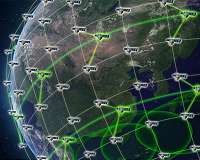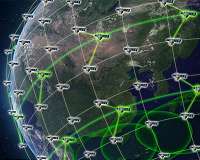
DARPA pit boss contractors SEAKR and SSCI team with DARPA to Get Blackjack early risk reduction orbital flights (Image Credit: SNN)
DARPA Blackjack program prime contractors SEAKR Engineering and Scientific Systems Company, Inc. (SSCI) are planning to utilize a collection small satellite presentations in an effort to verify and validate critical portions of their Blackjack program.
In partnership with all the U.S. Space Force, DARPA’s Blackjack program comes with an objective to ultimately start and examine a constellation of around 20 tiny satellites to demonstrate critical elements of global high-speed autonomous satellite programs at Low Earth Orbit (LEO), demonstrating a capability that could provide the Department of Defense with exceptionally linked, resilient, and steady overhead policy.
The first two satellites at the Blackjack constellation are scheduled for launch in late 2021. Prior to that, SSCI demonstration flights along with three SEAKR, all planned as chances, are scheduled to begin launching in 2020. Each flight intends to verify and validate vital technologies to be incorporated into Blackjack aquariums, to include ground software for satellite user accessibility and constellation independence, supercomputing, optical connections, and innovative processing, exploitation, and dissemination.
SEAKR Engineering is the Blackjack prime contractor to its autonomous assignment system. Pit Boss is a highly collaborative, distributed firm that’s intended process to self-task, and distribute tactically information that is relevant to manned and unmanned subscribers. The SEAKR solution comprises the supercomputing hardware along with teammate SSCI’s Collaborative Mission Autonomy Software of SEAKR.
As prime, the Blackjack app is supported by SEAKR with two risk reduction demonstration flights. The very first demonstration, Mandrake I, delivered on a cubesat, intends to demonstrate chip level technologies and key Pit Boss hardware prior to production. The orbital system comprises a twin and strives to get’real time’ efficacy feedback on chip performance and LEO radiation mitigations.
The Mandrake II airport demo, a DARPA partnership with Space Development Agency, forages early technology demonstration and confirmation of crucial Blackjack mission attributes. Mandrake II was made to engage laser communications between satellites and to ground assets with Blackjack constellation laser terminals. The demo merits SEAKR’s forward growing state of the art space-based net network capacities an integral part of the Blackjack Program, for Pit Boss.
SSCI meanwhile continues to create an early on-orbit risk reduction presentation of Pit Boss.
SSCI has executed an agreement to get a flight of the Pit Boss technologies of SSCI with assignment service supplier Loft Orbital to get to orbit. Loft Orbital intends to integrate the Sagittarius-A* Innoflight chip, packed with all the SSCI group’s autonomous conflict management command, control, and communications (BMC3) applications, on its own YAM-3 spacecraft, an ESPA-class assignment hosting quite a few government and business payloads.
Loft Orbital has a special capability to deploy assignments quickly due to agnostic interface port that allows a method of satellite assignments, along with its Payload Hub technology, a modular, bus agnostic. Loft Orbital also provides a turn-key command and control system which could be used by operators because of payload operations during reserved times of their day.
The Sagittarius A* assignment is meant to offer a demonstration of essential preliminary Pit Boss BMC3 software capabilities to autonomously handle a bus and payload to satisfy a tactical user’s”assignment service request” through prototype Blackjack human machine system interface (HMSI) ground program.
Displayed and information providers, in turn, are supposed to be disseminated on a important user display platform. The SSCI group’s open and modular BMC3 software was made to enable on-orbit upload and host of all third party exploitation algorithms, also known as”massless payloads”.
Several massless payloads are supposed to be flown, all of which can operate on vision info for demonstration of innovative mission capabilities. Sagittarius A* is intended to demonstrate Pit Boss’ capacity to receive data products from outside resources which will end in cueing and onboard autonomous tipping.
SSCI’s Vice President of Research and Development, Dr. Owen Brown, summarizes the mission’s possible:”This is extremely fascinating that SSCI’s Collaborative Mission Autonomy (CMA), further enabled by our teammate’s plug-in components and third party massless payloads, is scheduled to’fly’ in distance.
“Having a successful execution of Sagittarius A*, we could finish our journey of demonstration testing CMA in each one of the physical domains. The implication is that DARPA has generated a new technology paradigm which not only could offer BMC3 services for Proliferated LEO architectures, but also that same technology may help unlock lots of the capacities necessary for multidomain integration of smart systems working at the border”.
– Advertisement –








